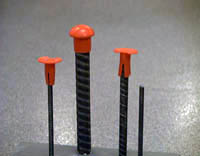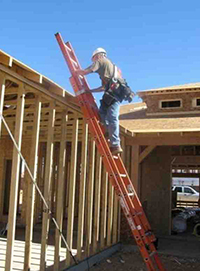Construction eTool
Construction » Falls
Falls are the leading cause of fatalities in the construction industry. An average of 362 fatal falls occurred each year from 1995 to 1999, with the trend on the increase.
It is important that safety and health programs contain provisions to protect workers from falls on the job. The following hazards cause the most fall-related injuries:

Am I in Danger?
Almost all sites have unprotected sides and edges, wall openings, or floor holes at some point during construction. If these sides and openings are not protected at your site, injuries from falls or falling objects may result, ranging from sprains and concussions to death.
How Do I Avoid Hazards?
- Use at least one of the following whenever employees are exposed to a fall of 6 feet or more above a lower level:
- Cover or guard floor holes as soon as they are created during new construction.
- For existing structures, survey the site before working and continually audit as work continues. Guard or cover any openings or holes immediately.
- Construct all floor hole covers so they will effectively support two times the weight of employees, equipment, and materials that may be imposed on the cover at any one time.
- In general, it is better to use fall prevention systems, such as guardrails, than fall protection systems, such as safety nets or fall arrest devices, because they provide more positive safety means.
Additional Information:
- 29 CFR 1926 Subpart M, Fall protection. OSHA Standard.
- 1926.501, Duty to have fall protection
- 1926.501(b)(1), Unprotected sides and edges
- 1926.501, Duty to have fall protection
- Worker Deaths by Falls: A Summary of Surveillance Findings and Investigative Case Reports. US Department of Health and Human Services (DHHS), National Institute for Occupational Safety and Health (NIOSH) Publication 2000-116, (September 2000).
Deaths Due to Unprotected Sides, Wall Openings,and Floor Holes
Case Reports:
The following Case Reports of falls investigated by OSHA illustrate how seemingly innocent workplace activities can have deadly consequences.
- An employee taking measurements was killed when he fell backward from an unguarded balcony to the concrete 9 1⁄2 feet below.
- A roofer, handling a piece of fiberboard, backed up and tripped over a 7 1⁄2 inch parapet. He fell more than 50 feet to ground level and died of severe head injuries.
- Two connectors were erecting light-weight steel I-beams on the third floor of a 12-story building, 54 feet above the ground. One employee removed a choker sling from a beam and then attempted to place the sling onto a lower hook on a series of stringers. While the crawler tower crane was booming away from the steel, the wind moved the stringer into the beam the employee was standing on. The beam moved while the employee was trying to disengage the hook, causing him to lose his balance and fall to his death.

Am I in Danger?
Working with heavy equipment and building materials on the limited space of a scaffold is difficult. Without fall protection or safe access, it becomes hazardous. Falls from such improperly constructed scaffolds can result in injuries ranging from sprains to death.
How Do I Avoid Hazards?
- Construct all scaffolds according to the manufacturer's instructions.
- Install guardrail systems along all open sides and ends of platforms.
- Use at least one of the following for scaffolds more than 10 feet above a lower level:
- Provide safe access to scaffold platforms. [Scaffold Access]
- Do not climb cross-bracing as a means of access.
Additional Information:
- 29 CFR 1926 Subpart L, Scaffolds. OSHA Standard.
- 1926.451, General requirements
- Scaffolding. OSHA eTool.
- Worker Deaths by Falls: A Summary of Surveillance Findings and Investigative Case Reports. US Department of Health and Human Services (DHHS), National Institute for Occupational Safety and Health (NIOSH) Publication No. 2000-116, (September 2000).
Deaths Due to Improper Guardrails on Tubular Welded-Frame Scaffolds
Case Reports:
The following Case Reports of falls investigated by OSHA illustrate how seemingly innocent workplace activities can have deadly consequences.
- An employee preparing masonry fascia for removal from a building fell from the third level of a tubular welded-frame scaffold. No guarding system was provided for the scaffold. Further, the platform was coated with ice, creating a slippery condition.
- A contract employee was taking measurements from an unguarded scaffold inside a reactor vessel when he either lost his balance or stepped backwards and fell 14½ feet, sustaining fatal injuries.
- An employee was installing overhead boards from a scaffold platform consisting of two 2" x 10" boards with no guardrails. He lost his balance, fell 71⁄2 feet to the floor, and was fatally injured.
- A laborer was working on the third level of a tubular welded-frame scaffold which was covered with ice and snow. Planking on the scaffold was inadequate, there was no guardrail, and no access ladder for the various scaffold levels. The worker slipped and fell head first approximately 20 feet to the pavement below.

Am I in Danger?
Unguarded protruding steel reinforcing bars are hazardous. Even if you just stumble onto an unguarded rebar you can impale yourself, resulting in serious internal injuries or death. [Rebar Accident]
How Do I Avoid Hazards?
- Guard all protruding ends of steel rebar with rebar caps or wooden troughs, or
- Bend rebar so exposed ends are no longer upright.
- When employees are working at any height above exposed rebar, fall protection/prevention is the first line of defense against impalement.
Rebar Caps

The OSHA Standard requires that rebar "be guarded to eliminate the hazard of impalement." Not all guards provide that level of protection. In some circumstances, the force of a fall can cause rebar to push clear through a plastic cap and still impale a worker, or the worker can be impaled by the rebar and the cap together.

Only rebar caps designed to provide impalement protection, such as those containing steel reinforcement, should be used.

This type of cap positions a 2 x 4 over the exposed rebar, and has been approved by California OSHA.
Excerpt from Mushroom Style Plastic Rebar Covers Used For Impalement Protection - OSHA Standards Interpretation and Compliance Letter 05/29/1997
"Tests designed by California OSHA were conducted that entailed dropping sand-filled canvas bags onto rebar protected by standard mushroom caps. Weights of the bags ranged from 140 to 160 pounds, and the bags were dropped from three, five and seven feet. The mushroom caps provided absolutely NO protection."
"Manufacturers of the mushroom caps agree that those caps were designed to provide SCRATCH PROTECTION ONLY and were never intended to prevent impalement, even at grade."
"Considering the serious nature of the hazard, the standard mushroom-style plastic rebar caps should not be used for protection against impalement. Protective devices capable of withstanding at least 250 pounds dropped from a height of ten feet should be used. Although there are no 'approved' mushroom caps on the market, steel reinforced covers and wooden troughs are available, and have been approved by California OSHA and recognized by the California AGC to meet the design criteria."
Bear in mind that, where possible, fall protection is still the best solution. A fall from 6 (six) feet or more on to a wooden trough or steel reinforced cap, even if it doesn't result in impalement, is still likely to produce serious injury.
Additional Information
- 29 CFR 1926 Subpart Q, Concrete and masonry construction. OSHA Standard.
- 1926.701, General requirements
- 1926.701(b), Reinforcing steel
- 1926.701, General requirements
- Mushroom Style Plastic Rebar Covers Used for Impalement Protection. OSHA Standard Interpretation, (May 29, 1997).
- Worker Deaths by Falls: A Summary of Surveillance Findings and Investigative Case Reports. US Department of Health and Human Services (DHHS), National Institute for Occupational Safety and Health (NIOSH) Publication 2000-116, (September 2000).
Deaths Due to Not Guarding Protruding Steel Rebars
Case Reports:
The following Case Reports of falls investigated by OSHA illustrate how seemingly innocent workplace activities can have deadly consequences.
- An employee pulling a concrete hose along a form fell two stories and hit his head on steel rebars which punctured his brain.
- A laborer fell through a roof opening about 8 feet to a patio foundation that had about 20 half-inch rebars protruding straight up. The laborer was impaled by one of the bars and died.

Am I in Danger?
You risk falling if portable ladders are not safely positioned each time they are used. While you are on a ladder, it may move and slip from its supports. You can also lose your balance while getting on or off an unsteady ladder. Falls from ladders can cause injuries ranging from sprains to death.
How Do I Avoid Hazards?
- Position portable ladders so the side rails extend at least 3 feet above the landing.
- Secure side rails at the top to a rigid support and use a grab device when 3 foot extension is not possible.
- Make sure that the weight on the ladder will not cause it to slip off its support.
- Before each use inspect ladders for cracked or broken parts such as rungs, steps, side rails, feet and locking components.
- Do not apply more weight on the ladder than it is designed to support. [Ladder Safety]
- Use only ladders that comply with OSHA design standards. [29 CFR 1926.1053(a)(1)]
Additional Information:
- 29 CFR 1926 Subpart X, Ladders. OSHA Standard.
- 1926.1053, Ladders
- Worker Deaths by Falls: A Summary of Surveillance Findings and Investigative Case Reports. US Department of Health and Human Services (DHHS), National Institute for Occupational Safety and Health (NIOSH) Publication 2000-116, (September 2000).
Deaths Due to Misuse of Portable Ladders
Case Report:
The following Case Report of falls investigated by OSHA illustrate how seemingly innocent workplace activities can have deadly consequences.
- An employee was climbing a 10 foot ladder to access a landing which was 9 feet above the adjacent floor. The ladder slid down, and the employee fell to the floor, sustaining fatal injuries. Although the ladder had slip-resistant feet, it was not secured, and the railings did not extend 3 feet above the landing.


